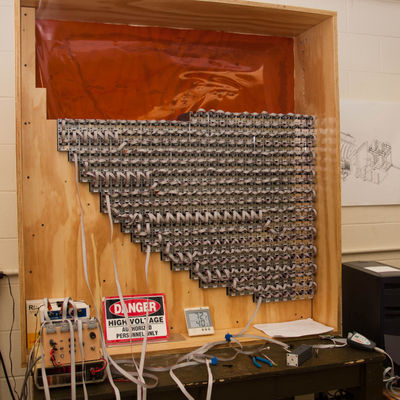|
|
| Line 5: |
Line 5: |
| | [[Image:Fcal_cw_test-1.jpg|thumb|400px|Production Cockroft-Walton Bases]] | | [[Image:Fcal_cw_test-1.jpg|thumb|400px|Production Cockroft-Walton Bases]] |
| | [[Image:Fcal_cw_test-2.jpg|thumb|400px|Cockroft-Walton Base Test Wall]] | | [[Image:Fcal_cw_test-2.jpg|thumb|400px|Cockroft-Walton Base Test Wall]] |
| − |
| |
| − | == Design ==
| |
| − | [[Image:Cell_wall_proto.jpg|thumb|200px|Cutaway view of prototype cell wall]]
| |
| − |
| |
| − | The current GlueX design is based of a design used for both the E852 and RadPhi cell walls. It consists of two thin plates with holes drilled at the PMT locations. The plates are then connected with soft iron sleeves that help magnetically shield the enclosed tubes. The void in between the plates and outside of the tubes is filled with epoxy to make the entire structure mechanically rigid.
| |
| − |
| |
| − | Preliminary mechanical drawings for a GlueX cell wall in the style of E852 and RadPhi cell wall were made by Eric Scott and can be found [[Media:Fcal_cell_wall_mech.pdf|here]]. The idea is that bases and PMTs (pictured to the right) would fit inside of the tubes and the square metal base would screw into the back plate of the cell wall. This design, however, does not include a mechanism for putting pressure on the light guide optical joint.
| |
| − |
| |
| − | One proposal for extending this design to allow a spring loaded joint is sketched on the blackboard below. The cell wall would be rigidly coupled to the device that holds the lead glass bars. A base/tube/light guide assembly is then slid into the iron sleeve of the cell wall and seated against the block. The screws are inserted through either coil springs or Belleville washers, through the base plate, and into the cell wall. Compression between the screw head and the aluminum plate on the PMT base provides pressure on optical joint. Variation in the distance that the base plate stands off the cell wall accommodates length variation in the base/tube assembly. Applied pressure is determined by tightening the screws and is independent of base/tube length.
| |
| − |
| |
| − | <center>
| |
| − | [[Image:Fcal_spring_design.jpg]]
| |
| − | </center>
| |

